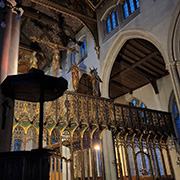 The 840 concerts in London were part of the long-vanished pre-Covid world and one which I had thought was gone for good, so it was a welcome surprise to see it resurrected with minimal fanfare after a five-year-plus hiatus. Can one go home again? Not exactly, as the concert last Saturday had relocated from their once-regular Islington haunt to St Cyprian’s, Clarence Gate. Otherwise, nothing seemed to have changed, with a programme that retained the same quietly reserved and very slightly precious mood that has become the series distinctive style. As usual, the instrumental forces were modest: works for two violinists and for piano duets. The gig began with the most prickly piece of the night, Marc Sabat’s Three Chorales for Harry Partch, a duet for retuned violin and viola. The earliest of his compositions, it draws on his career as a violinist and his study of microtonality to view Partch’s own use of microtonality under a microscope, creating a work of buzzing, vibrating slow-motion slewing, all subtones and doublestops. The two string players were Amalia Young and Anne Yin Han (apologies for not knowing which one played viola), who showed serious intent whether playing Sabat or arrangements of Diego Ortiz’s viol Recercades. The Ortiz pieces were interspersed through the night, having been arranged for violins by concert series curator Alex Nikiporenko. Co-curator Christian Drew indirectly echoed these pieces with his violin duet 17th Century Music, which struck me as a loose but airy collection of gestures toward the baroque era, minus the drive. (This is at least the second, possibly the third piece I’ve heard whose title riffs on Laurence Crane’s 20th Century Music – strange how influences can spread.) Darius Paymai’s sonnerie, air was another of the new pieces written for this concert and took a similar approach to Drew, this time giving Satie the languid treatment. The strongest of the new works was Nikiporenko’s Thread, an affecting violin duet that gained effect through taking intimate personal and sentimental inspiration to produce music that was securely woven together yet always translucent. The two pianists were Jay Austin Keys and Fernando Yada, who presented a suitably sensuous interpretation of Linda Catlin Smith’s Velvet which seemed to focus on the immediacy of touch ahead of overall shape, and a suitably dense version of Egidija Medekšaitė’s Textile 1 which reduced differentiation in the ever-changing small differences of interplay into a tight, seamless surface. The final work combined violins and pianos, James Creed’s Plain Song using sustained tones from an e-bow on the piano strings over which the musicians would sparingly add one or two notes to harmonise on the faint outline of a song.
The 840 concerts in London were part of the long-vanished pre-Covid world and one which I had thought was gone for good, so it was a welcome surprise to see it resurrected with minimal fanfare after a five-year-plus hiatus. Can one go home again? Not exactly, as the concert last Saturday had relocated from their once-regular Islington haunt to St Cyprian’s, Clarence Gate. Otherwise, nothing seemed to have changed, with a programme that retained the same quietly reserved and very slightly precious mood that has become the series distinctive style. As usual, the instrumental forces were modest: works for two violinists and for piano duets. The gig began with the most prickly piece of the night, Marc Sabat’s Three Chorales for Harry Partch, a duet for retuned violin and viola. The earliest of his compositions, it draws on his career as a violinist and his study of microtonality to view Partch’s own use of microtonality under a microscope, creating a work of buzzing, vibrating slow-motion slewing, all subtones and doublestops. The two string players were Amalia Young and Anne Yin Han (apologies for not knowing which one played viola), who showed serious intent whether playing Sabat or arrangements of Diego Ortiz’s viol Recercades. The Ortiz pieces were interspersed through the night, having been arranged for violins by concert series curator Alex Nikiporenko. Co-curator Christian Drew indirectly echoed these pieces with his violin duet 17th Century Music, which struck me as a loose but airy collection of gestures toward the baroque era, minus the drive. (This is at least the second, possibly the third piece I’ve heard whose title riffs on Laurence Crane’s 20th Century Music – strange how influences can spread.) Darius Paymai’s sonnerie, air was another of the new pieces written for this concert and took a similar approach to Drew, this time giving Satie the languid treatment. The strongest of the new works was Nikiporenko’s Thread, an affecting violin duet that gained effect through taking intimate personal and sentimental inspiration to produce music that was securely woven together yet always translucent. The two pianists were Jay Austin Keys and Fernando Yada, who presented a suitably sensuous interpretation of Linda Catlin Smith’s Velvet which seemed to focus on the immediacy of touch ahead of overall shape, and a suitably dense version of Egidija Medekšaitė’s Textile 1 which reduced differentiation in the ever-changing small differences of interplay into a tight, seamless surface. The final work combined violins and pianos, James Creed’s Plain Song using sustained tones from an e-bow on the piano strings over which the musicians would sparingly add one or two notes to harmonise on the faint outline of a song.
Creed also began the evening’s music, earlier at St Mary At Hill, at a free matinee concert given by Music We’d Like To Hear as part of London’s Open House weekend. Some curious punters who attended were quietly bemused by the works presented, a typically eclectic mix combining rarefied sublimities and literal piles of junk. Creed’s piece Lomond was written about five years ago but used the same method of Plain Song, this time producing faint traces of Loch Lomond out of the piano strings’ resonance. This time, the concept behind the work seemed to hold the piece together better. The programme was curated by Laurence Crane (q.v.) and featured the “GSMD Experimental Music Workshop and guests”, including Tim Parkinson and Angharad Davies. A scene from Parkinson’s opera Time with People (written about here earlier) was presented, performers crouched over small piles of aforementioned rubbish and producing a surprisingly broad palette of sounds from them as they muttered stop-start in unison. It made the following performance of Pauline Oliveros’s Rock Piece sound strangely monochromatic by comparison. John Lely’s Symphony No. 3: The Parsons Code for Melodic Contour is a near-unison work of blunted melodic obstinacy; the occasional deviations out of tune should undermine its solidity but instead just make it seem more threatening. Conversely, a rerun of Amber Priestley’s woozy derive Did not feel very well at skool (31/1/1977) became insidious by its dissipation, with the musicians scattered around the hall brewing up a thin but ominous musical miasma.
Filed under: Music, Reviews by Ben.H
Tags: Alex Nikiporenko, Amber Priestley, Christian Drew, Darius Paymai, Egidija Medekšaitė, James Creed, John Lely, Linda Catlin Smith, Marc Sabat, Pauline Oliveros, Tim Parkinson
No Comments »
Music We’d Like to Hear, 2023 (part 3 (there’s no part 2))
Thursday 20 July 2023
Stupidly, I missed the Friday night concert of Music We’d Like to Hear dedicated to pieces by Tim Parkinson, but I did get to the Saturday’s Amber Priestley gig. Pretty sure this is the first time I’ve experienced her work performed live; everything else so far had been heard over the radio. It’s not exactly like you’re missing out when you don’t see it, but the visual, or theatrical element to her compositions are intrinsic to what makes them work in their own way as music. Yes, it’s playful, and the theatrical elements are reminiscent of the jokey aspect present in work by other contemporary British composers, only without as much of the defensiveness or the regulated fun. More importantly, Priestley takes these stage antics beyond their usual sideshow role and deploys them as compositional techniques. The performance of her string quartet Ev’ry evening, ev’ry day demonstrated this most fully on the night. It was the most conspicuously active piece played – individual musicians sent in turn foraging around the room for additional score materials, crawling away to play in isolation on the floor, engaging audience members in square dance calls or just peacing out with a Tunnock’s Caramel Wafer – and so nominally the most distracting for the aural component, but this was part of the point. The inspiration for the piece was the disruptions encountered in everyday life, where simple tasks are thwarted by complications introduced by someone else. The ensemble never had a moment of coherence for long before someone got up, turned a fellow musician’s score to a different page and affixed an overlay or instructions that sent her on a digression. It resembled some of Luc Ferrari’s chamber pieces, in that musical progress is replaced by obligatory deviations: the clash of disparate textures and idioms suddenly changing or disappearing produced a kind of clotted antiphony through inadvertent accumulation of consequences. Moreover, these interruptions and obligations made you question whether any of this was in fact ‘fun’. At least you felt the audience were enjoying it more than the performers, which is as things should be.
The quartet themselves were game and able, both in running, walking, dancing and crouching with Priestley’s ideas, and in bringing out notable characteristics in material that might easily have been obscured. That substance was more evident in the other string quartet played that evening, And Yet Something Shines, Something Sings in that Silence: two pages of quasi-canonic passages which the musicians are required to interpret in a different tempo and loudness in each new iteration. At the end of each pass they pause, rotate the page 180 degrees and start over; repeat. This piece offered a loosely similar interplay of voices, but with greater consistency. The musicians were a mix of experienced players on the new music scene (Mira Benjamin on violin, Chihiro Ono on viola) and performance postgrads at Goldsmiths (Amalia Young on other violin; Kirke Gross on cello). After the interval they were joined by clarinettist Pete Furniss, Clare Spollen on piano (plus accordion) and James Creed on electric guitar to play Repeat yourself until friends are embarrassed…, a 41-minute work where the material is pre-pulverised. Goldsmiths’ students left musical doodles and sketches on large sheets of paper in the University corridors; these were then collaged by Priestley and the collages filmed and transformed to produce a video containing the resulting collages and other structures divided into quadrants on screen. The video may also function as a distraction, although the lack of spectacle to it diminishes that possibility. Musicians were scattered around the room, making music that on this occasion felt pretty low-key and sedate, at times more resembling an AMM-type group improvisation. The lack of a focal point may have been the issue, with all of the alienating factors of Priestley’s process fixed on tape in advance, with musical activity dissipated by the deliberately thinned-out density of musicians playing at any given time. Priestley herself was making occasional contributions here and there on various novelty handbells, having earlier been ushered into a brief impromptu violin part in Ev’ry evening, ev’ry day.
